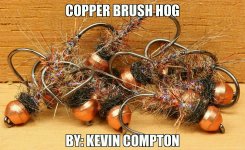same thing.
the nomenclature is the difference, more than anything else, but the terms are now accepted into different methods.
a "dubbing loop" is a loop of thread still on the fly, filled and spun.
a "dubbing brush" is created with a block, and after creation can be removed from the block until needed and tied in like a vernille (which it essentially is). this is what you buy when you purchase premade "dubbing brushes," or the same thing that jim leisenring would do when he would spin thread on prewaxed silk then store on a card for reference.
regardless of what you form the noodle otu of (silk, nylon thread, wire, etc) and what you fill it with (fur, feather, syntehtics) the item itself remains the same.
a decent loop tool goes a long way towards making an effortless looking fly. sharp scissors and quality wax are the other legs of that tripod.
as an aside, i'd like to point out that regardless of what people say, jim was not from allentown. lived, died, and worked in bethlehem. buried there to this day. billy joel is always messing up the program.




